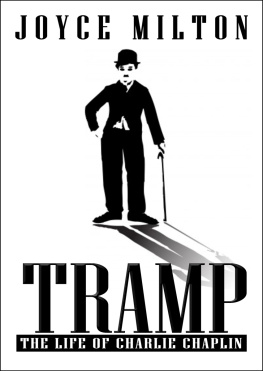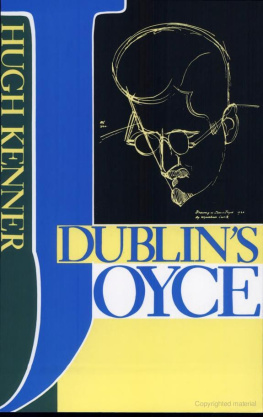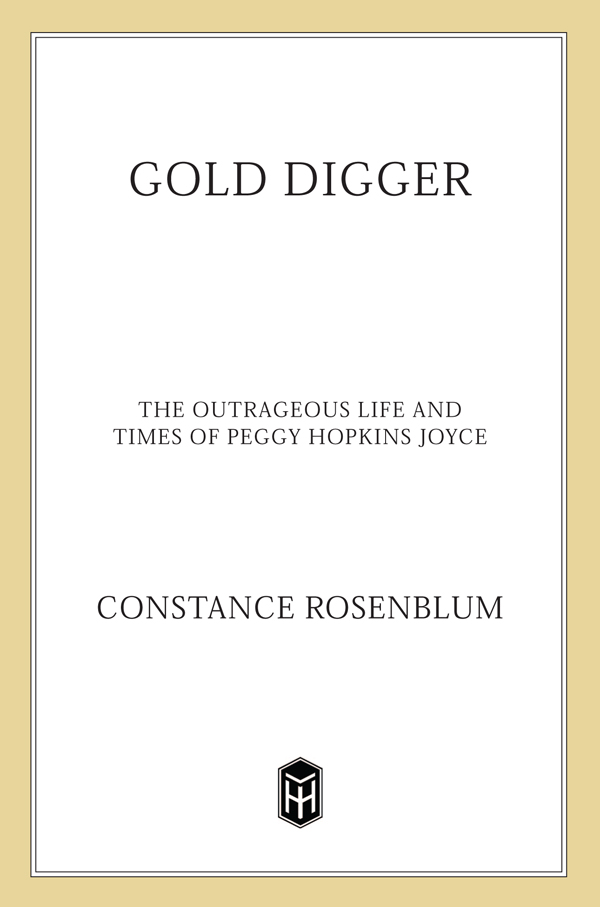Contents
Guide

The author and publisher have provided this e-book to you for your personal use only. You may not make this e-book publicly available in any way. Copyright infringement is against the law. If you believe the copy of this e-book you are reading infringes on the authors copyright, please notify the publisher at: us.macmillanusa.com/piracy.
To my mother, Beatrice Rosenblum,
and to my late father, Martin Rosenblum
She had wanted her funeral to be held at Saint Patricks Cathedral, the Gothic shrine to Catholicism on Fifth Avenue in Manhattan. The setting would have suited hera glamorous church for the woman who had been the quintessential glamour girl of her era. But arrangements with the church proved difficult, not surprisingly, given what a wild thing the deceased had been during her lifetime, and so on June 14, 1957, Peggy Hopkins Joyces last performance took place at the far more modest Saint Catherine of Siena, a sedate redbrick building a few blocks away on East Sixty-eighth Street. The funeral was small, attended by only a handful of people, none of them particularly famous. No record remains of what was said in her memory. After the service, escorted by her sixth and final husband, a retired bank clerk named Andrew Meyer, Peggys body was transported north to Gate of Heaven Cemetery in Mount Pleasant, New York. In the humidity of an early summers day, Peggy Hopkins Joyce was laid to rest in a dignified marble mausoleum shaded by two dogwoods, one red, one white.
Mausoleum notwithstanding, the rites by which Peggy found her eternal repose were fairly modest, with good reason. By the time she died, the same day as bandleader Jimmy Dorsey, her legacy was fading fast. Her obituary in the New York Times was buried deep in the paper, and most galling of all for a woman who had once been the photographers darling, a picture taken in her prime, all glowing and golden, was cruelly contrasted with one from the end of her life, when she had become fleshy and double-chinned. The show-business bible Variety gave her death just a few sentences, and the event merited only a brief item in Time magazine.
As the years passed, memories of Peggy Hopkins Joyce grew dimmer still. The twenties began to enjoy a renaissance as Will Rogers and habitus of the Algonquin Round Table found themselves immortalized on stage and screen. But hardly anyone remembered Peggy, despite the fact that she had been a Jazz Age diva who made international headlines for her extravagant lifestyle, her flamboyant ways, her frequent trips to the altarnot to mention the divorce courtand her torrid affairs with Charlie Chaplin, Walter Chrysler, all manner of European royalty, and dozens of other rich and celebrated men.
By the end of the century, only a few peoplegrizzled press agents who had toiled for Walter Winchell, veteran observers of the Broadway scenehad firsthand recollections, and even those were blurry. Just what had she been so famous for, anyway? For husbands, was that it? Six millionaire husbands, or so it was said; the much-married Peggy Joyce, she was called. And for her long-running role as a lover, although some people used less flattering terms like tramp. And for diamonds. And for furs.
* * *
I had never heard of Peggy Hopkins Joyce, and I came to know of her through a most unlikely route. Some years ago, my mother, an antiques expert, was asked whether she had any interest in a large carton of mysterious documentsyellowed clippings from long-defunct newspapers, letters in faded ink, receipts from bankers and jewelers who had closed their doors decades agodiscovered in an attic in Poughkeepsie, New York. How the box got there no one knew, but the contents had sat untouched for half a century.
The carton, it turned out, contained Peggy Joyces personal papers, and Peggy, I subsequently learned, had been the real-life inspiration for Anita Looss madcap heroine Lorelei Lee, the original blonde whom gentlemen preferred. Smart as a fox when it came to manipulating the opposite sex, Peggy had amassed the men, the furs, and especially the diamonds that were a girls best friend. Still, her name initially meant nothing to me, so for several years the papers remained crumpled in their box, slowly gathering more dust.
On the day that I finally began looking through them, however, I couldnt stop. There were hundreds of newspaper articles from all over the world, tracing in minute detail the life of a woman who seemed constantly to be falling in and out of love. There were notes on stiff cream-colored vellum, hastily scribbled in foreign hands and begging for late-night assignations. There were ardent love letters, pages and pages long, pitiful in their passion and desperation. There were Christmas cards from movie stars, invitations to parties at the smartest nightclubs, dunning letters from the most exclusive jewelers and dress shops in New York City. There were scrawled notes from impoverished young women in the hinterlands begging for a cast-off dress or a discarded diamond. One envelope contained the scraps of a newspaper article; when I pieced them together, I read a lurid account of a scandal involving high-class call girls in which Peggy had been implicated. She had clearly been furious but could not bear to throw away the evidence; despite the scurrilous allegations, her fear of being ignored was more powerful than her desire for respectability.
There were descriptions of her star turn in Earl Carrolls Vanities, one of the lusty revues of the twenties, from which a picture emergedPeggy descending a sweeping marble staircase, swathed in a flowing chinchilla gown worth tens of thousands of dollars, her throat and wrists aglitter with jewels, her hair a blonde cloud framing her exquisite face, her every glance and gesture sending charges of erotic energy toward a mostly male audience that all but salivated at the sight of her. Peggy was always a vision, it seemed, but never more so than when two thousand pairs of male eyes and a megawatt spotlight were riveted upon her, as they were the night she conquered Broadway.
In one small envelope I found a tiny golden horseshoe, a gift from an admirer. Another contained a lock of pale, peach-colored hair, slightly rough to the touch. Alone at my desk in the semidarkness, holding the little horseshoe and the faded curl, I had an eerie sense that the spirit of Peggy Joyce was not too far away.
This extraordinary cache of material, these tattered remains of a life, represented, it seemed, the achievement of a woman who had scaled the heights armed with nothing more than good looks, good luck, and sheer driving ambition. In this respect, the life of Peggy Hopkins Joyce represented a landmark in the evolution of American celebrity: she was hardly the first to flash into the public eye, but she was arguably the first to become famous in a certain way.
She made headlines not because she triumphed on the silver screen like Mary Pickford, or flew across the Atlantic alone like Amelia Earhart, or swam the English Channel like Gertrude Ederle, or helped precipitate a constitutional crisis like Wallis Warfield Simpson, or stood at the center of a sensational crime like Evelyn Nesbit, or nestled under the wing of a powerful media baron like Marion Davies, or was anointed debutante of the year like Brenda Frazier. She did nothing of significance except collect and discard rich husbands in rapid succession in an age when such behavior was severely frowned on. The husbands themselves were nothing special; what little fame they accrued came solely from having their names linked with hers.











